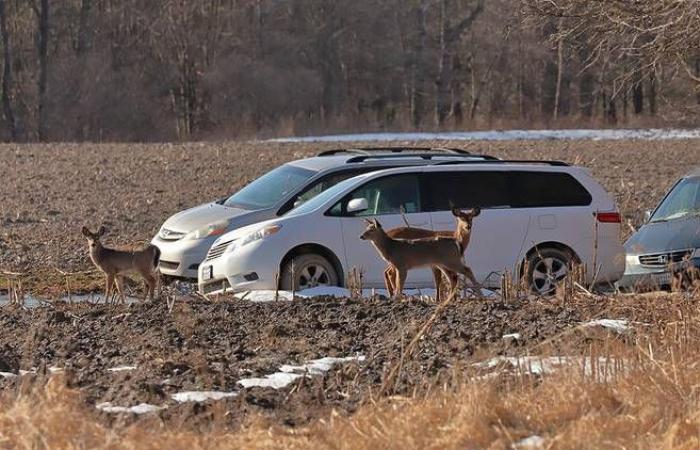Rescues take place almost every week on the border with Quebec.
The phenomenon of migrants who are in Canada and who wish to go to the United States is experiencing “a significant increase and is not slowing down,” observes Sergeant Charles Poirier, of the Royal Canadian Mounted Police (RCMP).
In the month of April alone, 1,492 people were intercepted by American customs officers after illegally crossing the border from Quebec, or around fifty per day. Meanwhile, Canadian police arrested 55 people illegally making the opposite journey. This would only be a small portion of the migrants who try it.
A Royal Canadian Mounted Police officer patrols Stanstead, a border municipality in Estrie. (Maxime Picard/La Tribune)
Montérégie has long been the region of choice for illegal smugglers, but they eventually spread to several municipalities in Estrie located along the American border.
“There is not really a clear line, but the bulk of illegal crossings occur in Montérégie and Estrie, particularly in the west of Estrie,” explains Sergeant Poirier, adding that Beauce is spared for the ‘moment.
(Journalist: Marie-Christine Bouchard | Videographer: Maxime Picard | Production and editing: Mòrag Bélisle)
Once arrested, migrants can apply for refugee status, or be quickly returned to their country of origin, if they are not in their first trouble with the law.
A municipality popular with smugglers
The border municipality of Saint-Armand, in Estrie, is particularly popular with smugglers, due to the large agricultural lands on the American side and the well-maintained paths on the Canadian side, which allow easier crossing than through wooded or watercourses.
Footprints in the freshly fallen snow alerted André Labelle. Two adults and a child had walked on his property, past his shed, then went to the street where they had obviously climbed into a car that was waiting for them. The Saint-Armand resident knew that they were illegal migrants who had just crossed the border between Canada and the United States on foot.
This van was abandoned on February 15. Two adults and a child left the United States on foot to travel to Canada. (Photo provided)
It was February 15th. The vehicle was still there when we visited last week, in the middle of the cornfield. It was finally towed away in recent days.
The man, who lives less than twenty meters from the border, saw in the distance an abandoned vehicle, all the doors open, in the middle of the field of his neighbor, an American farmer. The car got stuck in the mud, forcing the family to change their entry plans. This time, the migrants came from the United States and wanted to return to Canada. Usually it’s the other way around.
In this photo taken by a citizen, a tree branch has been planted in the ground and identified with a pink ribbon. (Anonymous)
This is an example of the many illegal crossings that André Labelle witnessed. During a walk in the forest behind his home, he discovered a large tree branch planted in the ground, decorated with a colored ribbon, undoubtedly used to mark a meeting point… or a drop-off point for delivery. Smugglers cross the border, yes. But what else are they going through? Drugs, weapons?
The mayor of Saint-Armand, Caroline Rosetti, believes that her municipality is “abandoned” and “left to its own devices” to manage a federal government problem.
“People almost happily cross the border,” she says.
“There, that’s enough! We need to feel support on the ground from the RCMP, and from the federal government as well. Since the start of the crisis, people have answered the phone, listened to us, told us ‘yes, yes’, but that’s not all that’s happening. There, we need to take action, to have an intervention plan.”
— Caroline Rosetti, mayor of Saint-Armand
Until last year, migrants crossing the border were mainly people looking for a better life, who organized themselves on their own. Today, these are “much more organized” groups.
“We see groups of 10-12 people, who are obviously expected. We also see that some carry weapons,” observes the mayor of Saint-Armand.
Reversed trend
It has been a year and a half now since Roxham Road was closed by the authorities. This passage, still illegal, was tolerated by the federal authorities installed there, who let illegal migrants enter, before registering them and directing them to resources.
“To some extent, the Roxham Road was facilitating. There was an abnormally high number of police officers on site, but the machine was well established, all the people passed through there, we took their identity, their fingerprints, we had a trace.
— Sergeant Charles Poirier, Royal Canadian Mounted Police
After the closure of the Roxham crossing, migrants stopped — or almost — passing through the forest to enter Canada. In fact, the smuggling networks have been reorganized. Without the RCMP understanding exactly why, Canada became a waypoint on their route to the United States and no longer a final destination.
“People enter Canada, most of them through the Montreal or Toronto airports, and they want to cross our land border to reach the United States illegally,” explains the RCMP spokesperson.
From coast to coast, 16,750 people were arrested on American soil after crossing the border with Canada last April. American customs officers made only 1,500 arrests directly at the border. The others took place after extensive investigations, after the illegal migrants had settled in Uncle Sam’s country for a few days or even several months.
Currently, residents of India and Turkey most often attempt to cross the border. They are helped by very well-organized smuggler networks.
“We must not hide it, these are real criminal groups, who act like criminals,” says Sergeant Poirier.
People who attempt to cross borders do so in the hope of finding a better life in a safe country. However, the activities of those who help them cross the borders disturb and worry the authorities and residents of the border areas.
“Clandestine border crossing is a very lucrative market. Smugglers can charge anywhere from a few hundred to several thousand dollars per person. These are criminal networks that abuse these vulnerable people.”
— Sergeant Charles Poirier, Royal Canadian Mounted Police
“We haven’t seen any human trafficking, fortunately, other than a few anecdotal cases, but nothing organized,” he continues. But it’s a risk. We have also seen unscrupulous smugglers who left people in very precarious conditions, in the middle of the woods, in the middle of the night, etc.”
A Royal Canadian Mounted Police officer shows an area where migrants often try to cross, through agricultural fields on one side and across the border. It is located here not far from Stanstead. (Maxime Picard/La Tribune)
He recalls a case from last winter where searches in the forest after a distress call made it possible to rescue migrants, not dressed warmly, who had gotten lost in the middle of the forest. Despite rescue efforts, one of them suffered frostbite so severe that it had to be amputated.
“Smugglers must make people believe that it is easy to cross the border on foot, but that is not the case. It’s difficult and it’s dangerous,” adds the RCMP spokesperson.
A game of cat and mouse is organized every day between smugglers and federal police officers, who are responsible for monitoring the border between Quebec and the United States, 813 km long.
It is the criminals who decide the rules of the game. Where will they go? At what time? Once a week or every day? Will they get as close as possible to the border by car or will they travel several kilometers through the thick forest on foot?
On the ground, police officers use different means to monitor the border bordered by forests, agricultural land and small municipalities: real-time recordings, drones, hunting cameras, dog handlers, nautical teams and calls from citizens.
Certain sectors are known as passage routes popular with smugglers, such as Wallace Lake, in Saint-Herménégilde, in the Coaticook MRC, much further east of Estrie. This lake is crossed by the border. All it takes is a small boat to cross it and change shores — and countries.
“Since the closure of Roxham Road, we have had approximately 8-9 calls from citizens who saw suspicious people, half of them on Wallace Lake. Citizens are very vigilant,” says Bernard Marion, prefect of the MRC of Coaticook.
Convicting smugglers remains a major challenge. First, because it is completely legal to walk along a border, as long as you do not cross it.
“When our agents intercept people near the border, it is difficult to prove beyond any doubt in court that they intended to cross,” says Sergeant Poirier.
Also, because as soon as people cross the border, Canadian police officers have to stop. Finally, because there is a lack of police officers on the ground to intervene quickly. At the start of the year, the RCMP reduced its numbers at the border, despite a historic increase in illegal crossings, in order to bring in more patrol officers to help with investigations, among other things.
On the ground, border residents note to what extent Canadian police officers are few in number and less well equipped than their American counterparts.
“RCMP officers often patrol alone, but there must be two of them to intervene. This lengthens intervention times,” explains André Lemieux.
In solution mode
RCMP officers deployed at the border are in solution mode to help border citizens who live with these illegal crossings, day and night.
“We know that there can be a feeling of insecurity for residents along the border. I would still like to point out that we have excellent collaboration with citizens, with elected officials, and that is very important for us,” explains the RCMP spokesperson.
But this is still too little in the eyes of the mayor of Saint-Armand, who is calling for involvement from the federal government. And quick.

Caroline Rosetti is the mayor of Saint-Armand, a small border municipality in Estrie. (Catherine Trudeau/La Voix de l’Est)
Caroline Rosetti wants the Liberal MP for Brome-Missisquoi, Minister Pascale Saint-Onge, to come meet her and work on developing an action plan. She would also like the federal Minister of Public Safety, Dominic LeBlanc, to be made aware of the problems at the border and to act quickly.
“Several years ago, farmers had to participate in the rescue of a pregnant woman in the woods, whom our first responders were not equipped to get out,” recalls the mayor. There are going to be dramas, again, perhaps also with our residents. Now is the time to act.”








